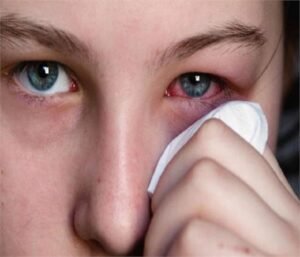Eye flu in kids: Eye flu also known as viral conjunctivitis is a common condition that affects children of all ages. It is characterized by inflammation and redness of the conjunctiva the thin tissue that covers the front surface of the eye. Eye flu can be caused by various viruses and while it is often a mild and self-limiting condition it is important for parents to recognize the symptoms and seek appropriate treatment to ensure the well-being of their children.
Read this also: Ayurveda: Harnessing Ancient Wisdom for Modern Well-being
Causes of Eye Flu

Eye flu is commonly caused by viral infections particularly adenoviruses. These viruses are highly contagious and can easily spread from one person to another through direct contact such as touching an infected person’s eye or sharing personal items like towels or pillowcases. Other viruses such as herpes simplex virus and enteroviruses can also cause viral conjunctivitis in children.
Symptoms of Eye Flu in Kids
The symptoms of eye flu in children may vary in severity and can include the following:
1. Redness and swelling of the conjunctiva
2. Watery or sticky discharge from the eyes
3. Itchy and irritated eyes
4. Sensitivity to light
5. Blurred vision
6. Crusty eyelids especially after sleep
7. Foreign body sensation or the feeling of something in the eye
8. Swollen lymph nodes in front of the ear or in the neck (in some cases)
Diagnosis and Treatment
Eye flu can usually be diagnosed based on the symptoms and a thorough examination of the eye by a healthcare professional. In some cases a sample of the eye discharge may be collected for laboratory analysis to confirm the presence of a specific virus.
Treatment for eye flu in children focuses on relieving symptoms reducing the risk of spreading the infection and preventing complications. Some common approaches include:
1. Eye drops or ointments: Prescribed antimicrobial eye drops or ointments can help alleviate symptoms and prevent secondary bacterial infections.
2. Warm compresses: Applying warm compresses to the affected eye can provide relief from discomfort and loosen any crusts or discharge.
3. Good hygiene practices: Encouraging children to wash their hands frequently avoid touching their eyes and refrain from sharing personal items like towels or pillowcases can help prevent the spread of the infection.
4. Symptom management: Over-the-counter artificial tears can help relieve dryness and discomfort while oral antihistamines may help alleviate itching symptoms.
5. Temporary lifestyle adjustments: It may be necessary for children to avoid swimming or other activities that can further irritate the eyes until the infection clears up.
Prevention
Preventing the spread of eye flu can be challenging especially among children who often come into close contact with one another. However these preventative measures can help reduce the risk of transmission:
1. Teach children proper hand hygiene including frequent handwashing with soap and water.
2. Encourage children not to touch their eyes unnecessarily.
3. Instruct children to cover their mouths and noses with a tissue when sneezing or coughing.
4. Advise children not to share personal items that may come into contact with their eyes such as towels pillowcases or eye makeup.
5. Promptly clean and disinfect surfaces and objects that may harbor the virus such as toys and doorknobs.
While eye flu is common in children it is usually a self-limiting and uncomplicated condition. By recognizing the symptoms early and seeking appropriate treatment parents can help their children recover quickly and prevent the spread of the infection. It is essential to promote good hygiene practices and educate children on preventive measures to reduce the risk of eye flu and other infections. If symptoms persist or worsen it is always advised to consult a healthcare professional for further evaluation and management.



